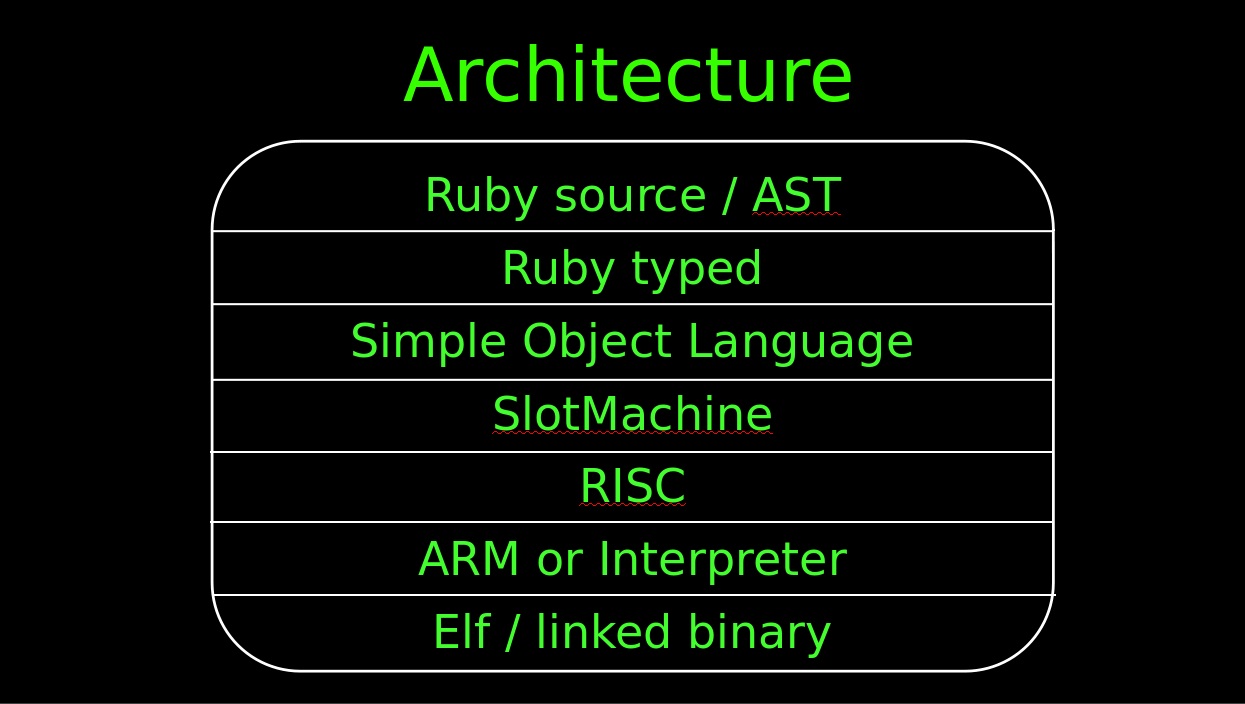Parsing parfait and other goodies ( 2019-08-20 )
As rubyx will eventually need to parse and compile itself, i am very happy to report success on the first steps towards that goal. Also better design, benchmarks, and another conference are on the list.
Compiling parfait
As a recap, Parfait is that part of the core library that we need already during compilation. Ie the compiler creates Parfait objects during compilation and uses Parfait code to do this. This off course is a conundrum, which is solved by using the Parfait Code as is in the compiler (and some ruby module magic to avoid name clashes)
Naturally any meaningful program that the compiler generates will use Parfait and so Parfait must be available at run-time, ie parsed and compiled. Since i have been busy doing the basics, this has been on the ToDo for a long while.
Now, finally, most the basics are in place and i have started what feels like a tremendous task. In fact i have successfully compiled three files. Object, DataObject and Integer, to be precise.
The significance of this is actually much greater (especially since there are no tests yet). Parfait, as part of rubyx, is what one may call ideomatic ruby, ie real world ruby. Off course i had to smoothen out a few bugs before compiling actually worked, but surprisingly little. In other words the compiler is functional enough to compile larger, more feature rich ruby programs, but more on that below.
Design improvements
The overall design has been like in the picture below for a while already. Alas, the implementation of this architecture was slightly lacking. To be precise, when SlotMachine code was generated, it was immediately converted to risc. In other words the layer existed only conceptually, or in transit. (Also it was called mom)

Now the code works exactly as advertised. Ruby comes in from the top and binary code out at the bottom. But more than that, every layer is a distinct step, in fact there are methods on the topmost compiler object to create every level down from ruby. This is obviously very handy for testing, and by iself sped up testing by 30%, as risc is not renerated before really needed.
Automated binary tests
Speaking of testing, we are at over 1600 tests, which is more than 200 up from before the design rewrite. At over 15000 assertions this is still 95% of the code, in other words everything apart from a few fails. And with parallel execution still fast.

But the main achievement a couple of weeks ago was the integration of binary testing into the automated test flow. Specifically on Travis.
This uses a feature of Qemu that i had not know before, namely that one can get qemu to run binaries from a different target on a machine, by simply calling it with qemu-arm.
Previously i had done testing of binaries via ssh, usually to an qemu emulated pi on my machine. This setup is vastly more complicated, as described here and i had shied away from automating that. Meaning they would happen irregularily and all that. My only consolation was that the test would run on the interpreter, but off course that does not test the arm and elf genertion.
The actual tests that i am talking about are a growing number of "mains" tests, found in the tests/mains directory. These are actual programs that calculate or output stuff. They are complete system tests in the sense that we only test their output (system output and exit code).
As we usually link to "a.out" files (thus overwriting and avoiding cleanup), the actual invocation of qemu for a binary is really simple:
qemu-arm ./a.out./bin/rubyxc execute test/mains/source/fibo__8.rbBTW, i have also created a rubyxc command to execute a file via the interpreter. This can sometimes yield better errors when things go wrong.
./bin/rubyxc interpret test/mains/source/puts_Hello-there_11.rbMisc other news
Microbenchmarks
At the last conference in Hamburg, someone asked the fair question: So how fast is it? It's been so long that i did tests, that i could only mumble. Now i finished updating the tests, but it will be a while before i can answer the question more fully.
So for starters, because the functionality of the compiler is limited, i did very small benchmarks. Very small means 20 lines or less, loops, string output, fibonacchi, both linear and recursive. I realized too late, that all that will tell about is integer performance.
Now because it's early days, i will not go into detail here. In general speed was not as fast as i had hoped for, about the same as mri. I will have to do some work on the calling convention and probably some on integer handling too. I think i can quite easily shave 30-50% off, and that alone should verify the saying that all benchmarks are lies. Like the one where rubyx is doing "hello world" faster than C. Yes, C, not mri. But only because i switched the buffering off, because also rubyx does not buffer (apples and oranges ...)
So i will take this round as inspiration to do some optimisation and performance measuring. And come back to it later.
Implicit returns
As part of parsing Parfait, i implemented a first version of implicit returns. Low hanging fruits, and in fact most common use cases, included constants and calls. So when a method ends in a simple variable, constant, or a call, a return will be added. More complex rules like returns for if's or while will have to wait, but i found that i personally don't tend to use them anyway.
Since class methods are basically methods (of the meta class), adding the unified return handling to them was easy too.
Improved Block handling
Block handling, at least the simple implicit kind, has worked for a while, but was in several ways too complicated. The block was unnecessarily assigned to a local, and compiling was handled by looking for blocks statements, not during the normal flow.
This all stemmed from a misunderstanding, or lack of understanding: Blocks, or should i say Lambdas, are constants. Just like a string or integer. They are created once at compile time and can not change identity. In fact Methods and Classes are also contants, and i reflected this in the SOL level by calling them Expressions, instead of before Statements.
So now the Lambda Expression is created and just added as an argument to the send. Compiling the Lambda is triggered by the constant creation, ie the step down from SOL to SlotMachine, and the block compiler added to method compiler automatically.
SOL coming into focus
I've been saying ruby without the fluff, to descibe SOL (Previously vool). And while that is true, it is quite vague. Two major things have become clear about SOL through the work above.
Firstly, SOL has no complex or recursive send statements. Arguments must be variables or constants. Calls are executed before and assigned to a temporary variable. In effect recursive calls are flattened into a list, and as such the calling does not rely on a stack as in ruby.
Secondly, SOL distinguishes between expressions and statements. Like other lower level languages, but not ruby. As a rule of thumb, Statements do things, Expression are things. In other words, only expressions have value, statements (like if or while) do not.
Plans
Calling
The Calling can do with work and i noticed two mistakes i did. One is that creating a new message for every call is unneccessarily complicated. It is only in the special case that a Proc is created that the return sequence (a SlotMachine instruction) needs to keep the message alive.
The other is that having arguments and local variables as seperate arrays may be handy and easy to code. But it does add an extra indirection for every access _and_ store. Since Mom is memory based, and Mom translates to risc, that does amount to a lot of instructions.
Integers
I still want to hang on to Integers being objects, though creation is clealy costly. In the future a full escape analysis will help off course, but for now it should be easy enough to figure out wether an int is passed down. If not loops can be made to destructively change the int.
SlotMachine instruction invocation
I have this idea of being able to code more stuff higher up. To make that more efficient i am thinking of macros or instruction invocation at the SOL level. Only inside Parfait off course. The basic idea would be to save the call/return code, and have the compiler map eg X.return_jump to the Mom::ReturnJump Instruction. "Just" have to figure out the passing semantics, or how that integrates into the SOL code.
Better Builtin
The generation of the current builtin methods has always bothered me a bit. It is true that some things just can not be expressed as ruby and so some alternative mechanism is needed (even in c one can/must embed assembler).
The main problem i have is that those methods don't check their arguments and as such may cause core dumps. So they are too high level and hopefully all we really need is that previous idea of being able to integrate SlotMachine code into SOL. As SlotMachine is extensible that should take care of any possible need. And we could code the methods normally as part of Parfait, make them safe, and just use the lower level inside them. Lets see!
Compiling Parfait tests
Since Parfait is part of rubyx, we have off course unit tests for it. The plan is to parse the tests too, and run them as a test for both Prfait and the compiler. Off course this will involve writing some mini version of minitest that the compiler can actually handle (Why do i have the feeling that the real minitest involves too much magic).
GrillRB conference
Last, but not least, i will speak in Wrocław in about a week. The plan is to make a comparison with rails and focus on the possibilities, rather than technical detail. See you there :-)
PS: Talk is now online here.
